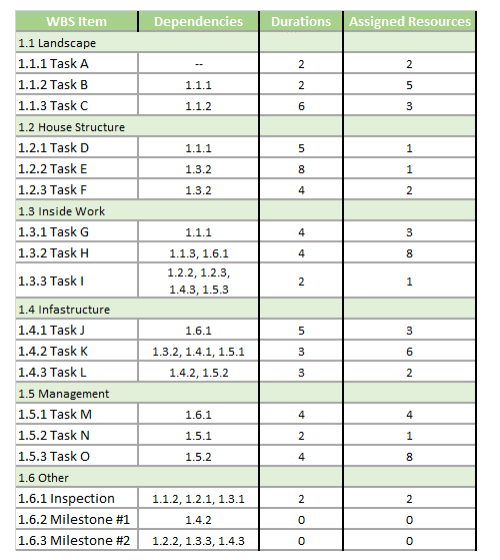Question
MGT2357 Assignment 2 Project Plan This assignment relates to the following Course Learning Requirements (CLR). CLR 1: Define the specific attributes of a project and
MGT2357 Assignment 2 Project Plan
This assignment relates to the following Course Learning Requirements (CLR).
CLR 1: Define the specific attributes of a project and its Lifecycle characteristics.
CLR 2: Create a Work Breakdown Structure (WBS) with the related organizational and cost control
structures.
CLR 3: Use Critical Path Method (CPM) and Gantt Project control tools.
CLR 5: Manage risk.
Objective of this Assignment:
Create the Project Plan for your dream home project.
The project management plan is the document that describes how the project will be executed,
monitored and controlled, and closed (Project Management Institute, 2017, p. 716. Project
Management Institute, 2021, p. 186).
Pre-Assignment Instructions:
1. Read the content of MGT2357 course modules 6 through 12, as well as the readings listed below,
and follow the learning activities embedded in the modules.
Readings
PMBOK Guide - Sixth Edition:
Part 1, Chapter 4, section 4.2. Chapter 6, Chapter 7, section 7.3, Chapter 8, section 8.1, Chapter 9,
section 9.1, Chapter 10, section 10.1, Chapter 11, sections 11.1 through 11.5.
Or
PMBOK Guide Seventh Edition:
In A Guide to the Project Management Body of Knowledge, Chapter 2, sections 2.4 and 2.5.
Assignment Tasks:
Create the project plan for your dream home project.
Reminder
The project budget is $300,000. The project is divided into the following work packages.
1. Landscaping (excavation, foundation, grading, driveway)
2. House Construction (frame, roof, siding)
3. Inside Work (floors, ceilings)
4. Infrastructure (electrical, plumbing, mechanical)
5. Management (management activities)
6. Other (inspections and milestones)
Your plan must include the items listed under Project Plan Sections in the Assignment Grading Rubric
and should be 8 to 10 pages in length (not including the cover page, table of contents, and
bibliography). The font used should be Arial 12 or Calibri 12. Text must be double spaced, but tables
may be single spaced.
Writing Guide
General Guidelines
Objective: Demonstrate your understandings of project management tools and techniques
covered in MGT2357 course modules and the PMBOK Guide.
Individual or Team assignment: You may partner with one or more other students on this
and/or any other course assignment. Please let the facilitator know if you have a teaming
arrangement in place, and make sure that all group members names appear on your
assignment.
Third-Party Material: Reference all third-party material that you use in the process of writing
your assignment. Use an established guide, such as APA or MLA to format your references.
Late Submissions: If a valid reason exists and you cannot submit the assignment on time, you
must notify the facilitator at least 24 hours in advance of the due date. Extensions are possible
under certain conditions. If an assignment is submitted late without approval, it can be subject
to late penalties as well as being returned with only a grade assessment (without
accompanying detailed feedback and comments).
Section-by-Section Guidelines
1. Title Page: You can have fun with your title page (illustrations and graphics), but at a minimum,
the title page must include the following information.
i. Your name (or the names of all members of your group)
ii. The course name
iii. The project name
iv. The date submitted
v. The following statement. All material prepared for this assignment was produced by the
author(s) and material from third parties (such as the Internet) has been cited and
referenced.
2. Table of Contents: The Table of Contents must be generated using your word processors builtin Table of Contents generation feature (found within the [Reference] Tab of Microsoft
Word). If you have not worked with the Table of Contents feature in the past, then this is a
good chance to learn some of Microsoft Words additional features.
3. Project Background: In this section create project background information in the form of a
Statement of Work (SOX), (Project Management Institute, 2017, p. 724. Project Management
Institute, 2021, p. 245), or a Business Case (Project Management Institute, 2017, p. 700. Project Management Institute, 2021, p. 236).
4. Project Scope (Project Management Institute, 2017, p. 717. Project Management Institute,
2021, p. 246). Describe the features of the projects end product.
5. Work Breakdown Structure (WBS): Use the data in the Table 1: Dream House Task Table
(below) to create the project WBS.
Note
Use the generic task names as they appear in the following table when creating your
WBS and all other sections of the Project Plan.

Table 1: Dream House Task Table
6. WBS Dictionary: Select one task from the WBS. Provide the following data specific to the task
you select.
i. Generic task identifier (e.g., 1.1.1 Task A). You may add a descriptive title if you wish (e.g., Excavate).
ii. Assumptions: Identify 2 assumptions that would be appropriate for a task of this nature.
iii. Constraints: Identify schedule or resource constraints that would be appropriate for this task.
iv. Requirements: Provide 2 requirements that would be appropriate for a task of this nature.
v. Quality Standards: Provide 1 quality standard for your task. The quality standard should
describe how the work is to be performed. This is different from the project requirements that describe what must be done.
vi. Deliverables: Provide 2 tangible deliverables that will be end-products of your task.
Provide a short description of each deliverable.
vii. Task Dependency: A task dependency is another task that must be completed before
your task can be started. Identify one schedule-related task dependency.
viii. External Dependency: External dependencies are outside of the Project Managers
direct control. They are organizations or individuals whose cooperation, support, or
approval is required for your task to succeed.
7. Project Gantt Chart: Use the data in the Table 1: Dream House Task Table to create the
project Gantt chart.
Note
You do not need to use any professional scheduling software. Charts produced using Excel, drawing software, and by hand are acceptable.
8. Critical Path (Network) Diagram: Use the data in the Table 1: Dream House Task Table to
create the project Critical Path (Network) diagram. Include both forward pas and backward
pass data.
Note
You do not need to use any professional scheduling software. Diagrams produced using Excel, drawing software, and by hand are acceptable.
9. Risks Management Plan (Project Management Institute, 2017, pp. 409-449. Project
Management Institute, 2021, pp. 122-127). Identify events that may or may not happen on the
project. Divide this section into the following subsections
i. Number One Risk Priority: Identify the most important risk. Explain why it is the most
important risk.
ii. Contingency Fund and Managerial Reserve: Determine the amount you will allocate to
the Fund and the Reserve. Describe the method you used to calculate the allocations.
iii. Risk Registry: Provide a risk registry table that includes the following columns, task WBS
number, risk number, risk description, likelihood of occurrence (high, medium, low),
impact (high, medium, low), strategy (escalate, avoid, etcetera).
10. Quality Management Plan (Project Management Institute, 2017, pp. 292-296. Project
Management Institute, 2021, pp. 87-91). For the task you defined in your WBS dictionary
create a quality control checklist that will be used to evaluate if the quality standard you listed
in your WBS dictionary has been achieved.
11. Communication Management Plan (Project Management Institute, 2017, pp. 374-377. Project
Management Institute, 2021, pp. 64, 157-158). Present a project communication plan in table
format, including the following columns, stakeholder communication requirements,
information to be communicated, frequency (e.g., daily, weekly, etcetera), sender, method,
receiver.
12. Human Resource (HR) Management Plan (Project Management Institute, 2017, pp. 316-317,
341. Project Management Institute, 2021, pp. 16-22). Provide an HR plan the includes the
following data.
i. Project team organization chart.
ii. Roles and responsibilities of 1 project team member.
iii. RACI chart (include all WBS items).
iv. HR topic: Explain how you would use 1 of the following items, team building, team
ground rules, recognition/rewards.
13. Project Budget: Provide a project budget in table format. Include the following columns, WBS
number, material, labor, total. Include all WBS items, as well as the contingency fund and the
management reserve. Be sure to stay within the $300,000 limit (validate by providing a total at
the bottom line of your table).
Step by Step Solution
There are 3 Steps involved in it
Step: 1

Get Instant Access to Expert-Tailored Solutions
See step-by-step solutions with expert insights and AI powered tools for academic success
Step: 2

Step: 3

Ace Your Homework with AI
Get the answers you need in no time with our AI-driven, step-by-step assistance
Get Started


